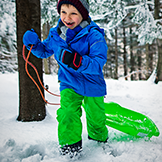
It’s not uncommon to hear people make offhanded, unofficial diagnoses of frostbite. But frostbite is a serious condition; it can be fatal. And frostbite can manifest in mere minutes following brief exposure to extreme cold.
Although typically perceived as a condition that only affects soft tissue, frostbite becomes an orthopedic issue when the circumstances are the most severe. Frostbite does attack the skin first, however. According to The American Academy of Orthopedic Surgeons, “Body tissues actually freeze when they are frostbitten. Ice crystals form in the cells, causing physical damage and permanent changes in cell chemistry. When the ice thaws, additional changes occur that may result in cell death.”
At the orthopedic level, severe cases of frostbite can prevent joints from working as they should, cause gangrene and require amputation. In children, frostbite can damage growth plates resulting in permanent deformities.
This is why it is essential to wear proper winter weather gear when you are exposed to cold temperatures, no matter how long the duration of time is expected. It is especially important to protect your extremities because the hands and fingers, nose, cheeks, ears, and toes are most vulnerable. This is due to the fact that when your body is exposed to extreme cold, your natural defenses kick in to protect your body’s core and vital organs first. The lack of blood flow to your extremities makes them more susceptible to injury.
Frostbite Prevention
Frostbite can catch people off guard. This is why awareness of the risks and how to prevent the condition is critical. Frostbite usually can be avoided if you prepare before going into a cold environment. Follow the six key tips to protect yourself from frostbite:
- Stay hydrated. When your body is dehydrated it struggles to retain warmth effectively. For the same reason, avoid drinking alcohol before spending time in cold weather.
- Dress in loose layers. Insulation is the trick to retaining body warmth. When you wear layers, they act similarly to insulation in your home, by trapping warm air between the barriers. You will stay warmer, longer when wearing several loose-fitting layers.
- Mittens protect your hands better than gloves. They create a pocket of warm air, insulating your fingers.
- Make sure that your ears are completely covered by a hat, headband, or secured scarf. Do not wear earrings; the metal running through your lobe will cause your ear to freeze at a faster rate.
- Keep your heart rate up. Movement and exercise will increase blood flow throughout your body, especially to your extremities, where frostbite is the biggest risk.
- If you get wet, get out of the cold immediately and change into warm, dry clothing.
Frostbite Symptoms
If you experience any of the following symptoms after exposure to cold temperatures, contact your doctor immediately.
- Tingling and/or stinging
- Numbness
- Shiny, waxy-looking skin
- Flesh discoloration
- Muscle and joint stiffness
- Blisters
As soon as you suspect you may have frostbite, warm the affected area. If you can, soak in warm water. It is important to make sure the water isn’t hot so that you don’t burn the already injured skin. Do not use a heating pad or other source of electric-powered heat as it can cause burns. If your feet or toes are frostbitten, do not walk on them until you see a doctor. Do not rub the frostbitten skin with anything abrasive; if you need to touch the affected area, do so gently so that the skin isn’t irritated further. If you are experiencing pain, it is okay to take ibuprofen according to the dosage instructions on the package.
Because frostbite can cause long-term health complications, it is always important to consult your physician if you suffer from any degree of frostbite. Self-diagnosis and at-home treatments can complicate healing if done so improperly. An expert opinion is best in this case. If you’d like an orthopedic perspective on your condition, contact a MOSH doctor who specializes in the applicable area such as hand or foot care.